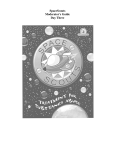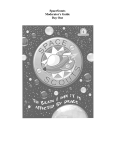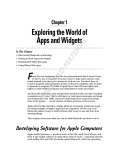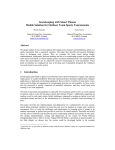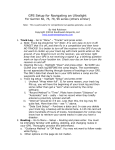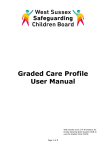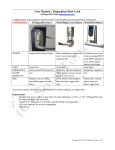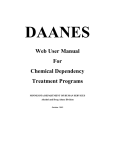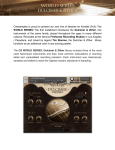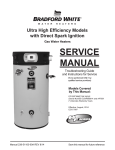Download Space Scouts Moderator Guide #2
Transcript
SpaceScouts Moderator's Guide Day Two SpaceScouts Moderator's Guide Day Two Page 1 Introduction Welcome to SpaceScouts. This program is specifically designed to teach fourth- through sixth-grade students about the biological bases of substance abuse. After viewing the program in its entirety, students should have an excellent overview of what drugs do to the brain and body. The program is not designed to prevent students from using drugs, but rather help them gain a better appreciation for what happens when people do use drugs. Program Overview The program begins with the moderator dividing participants into teams and determining which team will go first. Although SpaceScouts is primarily a video, the action stops at several points to allow for participants to complete workbook exercises and physical activities and games. The moderator may wish to assign a player from each team to be 'official scorekeepers.' Moderators The moderators are responsible for insuring the overall smooth operation of activities during the use of the program. They also help ease the transitions between the screen, physical activities, and workbook exercises. Although the moderators need to maintain a level of control, they should also be relaxed and energetic. Moderators do not need to have a background in substance abuse education in order to run SpaceScouts’ activities. Content essays from which the program was created are included in the back of this manual. There may be times when disputes occur between the teams. There also may be times when individual team members are ridiculed for answering a question incorrectly. During these times, the moderators will need to arbitrate to insure that everyone is treated with respect. Moderators may also need to show a level of adaptability and sensitivity to group characteristics. Moderators may want to show some leniency and allow honest efforts to count as correct responses to the workbook exercises. Judging the level of sophistication of the group members should guide these types of decisions. There will also be times when participants draw posters and share them with the group. Moderators should be prepared to praise all efforts and quell any negative comments or teasing by others. Moderators should stress the importance of mutual support, respect, and learning. Using This Guide This guide contains a broad overview of the SpaceScouts video and the instructions for running the activities. Also included are copies of the students’ workbook pages. Text appearing in quotes is for the moderator to speak. Text preceded by the » symbol indicates action for the moderator to take. Running the Program This program can be run from either a traditional DVD player or from a computer equipped with an internal DVD drive. Directions for each are described below: Using a DVD player The video should function as a conventional DVD disc. Refer to your player’s user manual regarding use of the Using a Macintosh Computer Insert the disc into the computer. The disc will automatically begin playing. The mouse may be used to click buttons on the screen. A button that is green will activate with one click, while a yellow button will turn green with one click and activate with another click. When you touch the track pad or move the mouse, a thin transparent window will appear that contains controls resembling a remote control (see diagram inside front cover). Use the play, pause, and forward buttons to control the flow of the program. After five seconds of no input from the track pad or mouse, this 'virtual remote' will hide itself. Note: In some instances when the disc is inserted a dialog may pop up. If this happens, clicking the 'beginning of disc' option will start the video as expected. Additional note: There is an 'eject' button on the virtual remote. If this button is clicked, the disc will be ejected from the computer. In order to continue, the disc must be fully removed and reinserted. The video will then begin playing inside a small window. To make the video fill the screen, click on the video to insure that the DVD player program is activated and then from the 'Video' menu select the 'Enter Full Screen' option. Quitting The Program On Macintosh computers, press Command-Q. Drag the disc icon to the trash icon in the dock (the trash icon will turn to an 'eject' symbol). For traditional DVD players, follow your unit’s standard operating procedures. Other Items Needed For the activities, have on hand 2 buckets or bins, a few dozen foam rubber tennis-ball-size balls (or wadded up pieces of paper), and a roll of masking tape (to mark lines on the floor to indicate the beginning and end points of the various races). SpaceScouts Moderator's Guide Day Two Page 2 Program Introduction "Welcome back to SpaceScouts. I think you're going to enjoy this program. We'll be watching some videos, doing some workbook activities, and playing some games. In today's lessons we're going to learn about substance abuse and how certain drugs affect the brain and body. But first we have to divide up into teams." » Divide kids into two teams; have the teams sit together facing the screen. Assign one team to be Red and the other Blue. Assign one person from each team to be 'official scorekeepers' or keep score yourself. "Here are your workbooks. We'll be using them later. No need to look at them now." » Hand out workbooks. "OK. Let's begin." » Launch the program. It will automatically show the introduction and first scene in Andre’s bedroom » Upon completion, the program advances to an activity screen SpaceScouts Moderator's Guide Day Two Page 3 Activity #1 – Drug Match “Has everybody played Concentration before? This game is a lot like that.” - Lay out large laminated cards face down on the floor in a 4x4 array - Read the following instructions: - On the face of the cards are either: o A picture of a drug and its name o A description of a drug and its name - Teams will take turns turning over two cards - As the cards are turned over, participant must read what it says to the group - If a match is made, the team collects the cards and gets another chance to turn over two cards - If no match is made, both cards are turned face down once again and the other team gets a turn - Continue until all matches have been made. » » » » Add the number of matches to each team's score Ask the 'official scorekeepers' to tally the score Click on the 'Jump' button if both teams have the same score Click on the 'Continue' button to proceed “OK, XX team won, so you guys get to choose which scene we’ll see first of these three. Don’t worry, you’ll get to see them all.” » Winning Team gets to select which of the following they want to view; click on that one - Nicole - Andre - Kitchen The remaining locations will be seen automatically followed by • Papa Franklin talks to kids • Coach arrives • Twister game Program automatically advances to workbook exercise. SpaceScouts Moderator's Guide Day Two Page 4 Workbook Exercise #1 – Legality & How Taken "Open your workbooks to the first page. In the center column, you’ll see a list of drugs. The left column is a list of how various drugs can be taken, and the right is whether or not the drug is legal. You have two minutes to match the name of the drug, how it’s taken, and whether it is legal or not. Ready, Go" » Click on the 'Start' button When timer expires, buzzer sounds "Pencils down, everyone" » Click on the 'Continue' button to advance » Read through the all the pairings displayed on the screen "OK, this is your chance to show your honesty. Count up how many you got correct." "Everyone stand up. If you got less than five correct, sit down. OK, now if you got less than seven correct, sit down.... " » Continue asking to identify who got the most correct » Add the highest number of correct answers by a single team member to that team’s score » Ask the 'official scorekeepers' to tally the score » Click on the 'Jump' button if both teams have the same score » Click on the 'Continue' button to proceed with video. • Yard sale • Clown makeup • Andre wears lamp • Andre leads basketball practice • Andre and Franklin • Andre and Coach Program advances automatically to workbook exercise SpaceScouts Moderator's Guide Day Two Page 5 SpaceScouts Moderator's Guide Day Two Page 6 Workbook Exercise #2 – Rat Experiment "In this experiment, we have three different rats. One will get to drink a lot of soda. Another will get a little bit of soda. The third rat will just drink water. Get out your workbooks and open them to page two. For each rat, write down your HYPOTHESIS – what you think will happen to each rat." » Wait until everyone writes something in their books "Now, let's see what happens when we run the EXPERIMENT" » Click on the leftmost video icon. When that is complete, click the middle video and then the rightmost video. When all three animations have been viewed, click 'End Experiment' button to move on. If you click before viewing all three animations, click ‘Back’ to return. "Now, write down in your workbook the EXPERIMENTAL RESULTS – what actually happened." » Wait until everyone writes something in their books "Now make some CONCLUSIONS as to what you think the results mean" » Wait until everyone writes something in their books "So a scientist may hypothesize that the sugar in soda would make rats more fat. They would then do an experiment to test their hypothesis. Today, our experimental results confirmed the hypothesis – the more soda a rat gets, the fatter he will be. Therefore, we can conclude that something about soda leads rats to gain weight. How might we follow this study up to refine our results? Write down some EXTENSIONS – other studies we could run to confirm our conclusions or test other hypotheses." » Wait until everyone writes something in their books » Click on the 'Continue' button » Add to each team's score when they come up with a viable follow-up experiment such as: - feed one rat a caffeinated soda and one rat a regular soda - feed one rat a diet soda and one rat a regular soda - etc. » Ask the 'official scorekeepers' to tally the scores » Click on the 'Continue' button to proceed with video • Coach practices speech • Coach gives speech • Museum exterior • Museum interior (lobby and Oliver’s office) • Andre, Nicole and Terrance The program automatically advances to activity screen SpaceScouts Moderator's Guide Day Two Page 7 SpaceScouts Moderator's Guide Day Two Page 8 ACTIVITY #2 – Musical Chairs "Everyone stand up. Help me make a circle of chairs" » Arrange chairs in a circle, backs facing inward – 1 chair less than the number of participants "OK, now we're going to play musical chairs. I'm going to play some music. When it stops, you have to sit in a chair. If there's no chair available, you're out – no pushing, please" » Click on the ‘Start’ button to start the music "Come on, guys. I wanna see you move. Keep going and enjoy this music" » Click on the pause button (DVD controller) or space bar (keyboard) to stop and restart the music. » Click on the right arrow key on the keyboard or forward button on DVD controller to end the game. "OK, if you didn't land in a chair you're out. Let's do it again..." When the music stops, everyone must sit in a chair. The person who remains standing is out for the remainder of the game. Remove one chair from the circle, and start the music again. Repeat until there is one person left. If the music ends before you are down to one person, you may click on the 'More Music' button to begin again. » Add 10 points to the winning team's score » Ask the 'official scorekeepers' to tally the score. » Click on the 'Continue' button to proceed with video • Coach and Oliver • By vending machines • Coach and team in museum lobby “OK everybody, good job. It’s time to take a 10-minute break and change DVDs.” » On a traditional DVD player, eject the disc and reinsert the second disc when ready to begin again. » On a Macintosh computer, press Command (apple key)-Q, drag the disc icon to the trash (the trash will turn into a eject icon). Remove the DVD and insert the new disc when ready to begin again. » Note – if a dialog box appears when the disc is inserted, choose the 'beginning of disc' option. » Additional Note – if the video doesn’t play in full screen, choose the 'Enter Full Screen' option from the 'Video' menu. SpaceScouts Moderator's Guide Day Two Page 9 Beginning of Disc #2 " OK, You just learned about How Legal Substances Can Be Abused. Let's continue on and see what happens to Nicole and Andre." » Disc should begin automatically when placed in drive • Andre and malt cups • Coach and Oliver » Upon completion, the program automatically advances to activity screen ACTIVITY #3 – Find Your Twin "Everyone open your workbooks to the inside back cover where you’ll see a bunch of vocabulary words. Notice at the bottom that there are four traits listed: eye coloring, tongue rolling, thumb curvature, ear lobe. When I say 'go' I want you to find someone who has the same traits as yourself using these four characteristics – for example you'll both have brown eyes, can curl your tongue, have a curved thumb, and detached earlobes. You don't have to limit yourselves to teammates. You'll have 3 minutes. But if a pair shouts 'FOUR' before then, they'll be the winners." » Wait until everyone has looked at the examples in the workbook "GO" » Click the 'Start' button » If a pair has shouted "FOUR," they win; otherwise identify the pair that has the most traits in common when the timer expires. "OK, guys, come on up and show everyone why you're twins." » Call winning pair up to front and make them demonstrate their matching traits. » Add one point for each trait matched to the winning pair’s team » if the pair members come from both teams, both teams get the points. » If there is a tie, use 'Jump' button » Ask 'official scorekeepers' to tally the score » Click on the 'Continue' button to proceed with video • Farmers’ market • Andre and Charlene at malt shop • Booker T and Kennedy at hot dog cart • Franklin and DJ • Coach and team in museum lobby » The program automatically advances to the next exercise screen SpaceScouts Moderator's Guide Day Two Page 10 Workbook Exercise #3 – Map to the Museum "Open your workbooks to page 3. You'll have three minutes to figure out how to get coach back to the museum. Ready, go." » Click on the 'Start' button When timer expires, buzzer sounds "Pencils down, everyone" » Click on the 'Continue' button » Read through the map route displayed on the screen "OK, this is your chance to show your honesty. Stand up if you got it correct." » Adjust each team's score to reflect # of kids standing » Have the 'official scorekeepers' tally the score » Click on the 'Jump' button if both teams have the same score » Click on the 'Continue' button to proceed with video • Basketball court and park • Andre and Coach at picnic table » The program automatically advances to workbook exercise SpaceScouts Moderator's Guide Day Two Page 11 SpaceScouts Moderator's Guide Day Two Page 12 Workbook Exercise #4 - Risk & Protective Factors "Open your workbooks to page 4. This team here, you'll be 'Risk Factors' and this team here, you'll be 'Protective Factors.' When I say 'go,' I want you as a team to fill in as many things as you can think of in three minutes that will either help people stay away from drugs, or encourage them to use drugs. Ready, go." » Click on 'Start' button to begin the activity. When timer expires, buzzer sounds. "OK, let's hear all the 'Risk Factors' you came up with – other team, I want you to be writing these down in your workbooks." Moderate the reading of the list, give a point for each reasonable answer. If the following aren't mentioned, do a brainstorming session to elicit more: “You gave some great answers. I wonder if the whole group could come up with a few more.” - RISK - Neighborhood violence - Lots of advertising for alcohol & cigarettes - Family that use - Friends that use - Attitudes that say that drug use is OK - Inability to handle stress » Click on ‘Continue’ to proceed "OK, now let's hear the 'Protective Factors' – other team, remember to write their answers in your books." Moderate the reading of the list, give a point for each reasonable answer. If the following aren't mentioned, do a brainstorming session to elicit more: “You gave some great answers. I wonder if the whole group could come up with a few more.” - PROTECTIVE - Involvement in outside activities » sports, church, etc. - Family that does not condone use - Friends that do not use - Attitudes that say that drug use is not OK - Knowing how to effectively handle stress » Click on ‘Jump’ if there is a tie, or ‘Continue’ to proceed with video SpaceScouts Moderator's Guide Day Two Page 13 SpaceScouts Moderator's Guide Day Two Page 14 "OK, where should the team go first before practice? Team XX, you won the last round, which should we see first. The other two will follow." » Winning Team gets to select which of the following they want to view first; click on that one - Playground - Balance Beam - Pavilion The remaining locations will be seen automatically and the video will proceed with • Feeding the ducks » The program automatically advances to workbook exercise Workbook Exercise #5 – Media ID " Open your workbooks back to page four. At the bottom, it says ‘Media ID.’ As you watch the following video, quickly write down all the drugs images you see. Ready, go." » Click on the 'Start' button » When video ends, program automatically advances to next screen "Pencils down, everyone" "Exposure to drug imagery via advertising, TV, and the movies is an important risk factor. However, being able to recognize these images for what they are is an even more important protective factor. Let's see how well you did." » Click on the 'Continue' button to proceed » Read off the complete list of items from the screen " Everyone stand up. Sit down if you had less than 5. OK, now sit down if you had less than 8..." » Continue asking to identify who got the most correct » Adjust each team's score to reflect # of items correctly identified » Click on the 'Jump' button if both teams have the same score » Ask 'official scorekeepers' to tally score » Click on the 'Continue' button to proceed Program automatically begins to show remaining video scenes • Coach, Andre and Oliver • Coach and Oliver • Franklin cooks, sort of • Aretha, Franklin, Andre and Nicole in front room • Credits "It looks like the XX team is the winner. Congratulations. Leave your workbooks and pencils with me. We're gonna let you go now, and I hope you'll all be back next week. Before you go, we have some prizes for you. Since XX team won, how about you guys coming up here first and picking your prizes. After that, the other team can come forward. I hope everyone enjoyed our program and that you learned a lot about the brain and how it is affected by drugs. Looking forward to seeing you next week." » On a traditional DVD player, eject the disc and power off. » On a Macintosh computer, press Command (apple key)-Q, drag the disc icon to the trash (the trash will turn into a eject icon). Remove the DVD and shut the laptop lid. SpaceScouts Moderator's Guide Day Two Page 15 SpaceScouts Moderator's Guide Day Two Page 16 CONTENT ESSAYS Lesson 2, Objective 1: Describe five types of drugs, how they’re taken and if they’re legal Alcohol is a liquid. Alcoholic beverages come in many forms. Beer, whiskey, wine, and wine coolers all contain alcohol. A twelve-ounce can of beer, a five-ounce glass of wine, a shot of hard liquor, and a mixed drink all contain the same amount of alcohol. Drinking alcoholic beverages is legal for adults 21 years of age or older. Cocaine is a white powder that is made from the leaves of the coca plant. Cocaine can be snorted, smoked, or injected. Sometimes cocaine powder is made into small rocks called “crack.” Other names for cocaine include “snort,” “blow,” and “coke.” Cocaine is illegal. Inhalants are the fumes from some types of chemicals. People breathe these fumes to get high. This is called huffing. Inhalants include such things as gasoline, spray paint, and glues. Many inhalants are legal products, but they are used in ways for which they were not intended. Marijuana is a drug made from the leaves and flowers of the cannabis sativa plant. Marijuana can be smoked or eaten. Other names for marijuana include “pot,” “weed,” “grass,” “dope,” and “chronic.” In the United States, using marijuana is illegal. But sometimes, doctors prescribe marijuana for certain illnesses, such as pain caused by cancer treatment. Nicotine is one of the many chemicals found in tobacco. Tobacco can be smoked or chewed. Using tobacco is legal for adults. Lesson 2, Objective 2: Describe how legal substances can be abused All drugs cause changes in the brain or body. But not all drugs are illegal. Some legal drugs include medicines doctors prescribe or drugs bought at a store. Even though these drugs are legal, people can take them in ways they are not intended. Drinking alcoholic beverages and smoking cigarettes is legal for adults. But some people abuse these substances and can become addicted. Caffeine is a drug that is often found in soda. It causes people to feel energized and alert. Although caffeine is legal, people may drink more caffeinated soda than they should. Some people eat too much sugar in sweets like ice cream, candy, and soda. This can cause obesity. Being obese, or overweight, can lead to a disease called Diabetes. Diabetes is a disease that prevents the body from controlling the amount of sugar in the blood. Diabetes is common among African-Americans. Many foods also contain high levels of salt. Some people add salt to their foods both before and after cooking. Although salt helps food taste better, using too much salt can be bad for the body. Over use of salt can lead to hypertension, or high blood pressure. Hypertension is one of the main causes of strokes and heart attacks. SpaceScouts Moderator's Guide Day Two Page 17 Lesson 2, Objective 3: Explain what genes are and describe their role in drug abuse Our bodies are made up of millions of tiny cells. Each cell has many smaller parts. One of the most important parts is the nucleus. The nucleus contains 23 pairs of chromosomes. Chromosomes are made of many different genes. Genes are like chemical instruction manuals that tell the body how to build itself. Children’s genes are a combination of their parent’s genes - half from their mother, and half from their father. Most traits, or how people look and act, are due to a combination of many different genes. Some genes may play an important role in determining whether a person will develop a drug abuse or dependency problem. Having some genes may make people more vulnerable to the effects of drugs. Other genes may make people less likely to abuse drugs. No one gene can cause drug dependency or abuse. No matter what genes people have, their genes are just one factor that determines the likelihood of them becoming addicted to drugs. Lesson 2, Objective 4: Explain how risk and protective factors influence drug use Some things in people’s lives make it more likely that they will use or abuse drugs. These are called risk factors. One risk factor for using drugs is having friends or family members who use drugs. Another risk factor for using drugs is living in a violent neighborhood where drugs are easily obtained. Peer pressure is another important risk factor for using drugs. Other things in people’s lives make it less likely they will use or abuse drugs. These things are called protective factors. One protective factor for not using drugs is having parents who don’t use drugs. Being involved in activities such as sports or church also helps people stay away from drugs. Having friends who don’t use drugs is another important protective factor. You can’t tell if a person will end up using drugs just by looking at their risk and protective factors. The importance of various risk and protective factors changes during a person’s life.




















